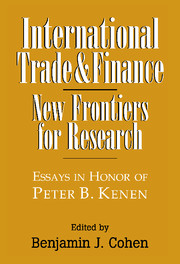Book contents
- Frontmatter
- Contents
- List of contributors
- Introduction
- 1 The practical theorist: Peter Kenen's contribution to international economics
- I International trade theory
- 2 Nature, capital, and trade: A second look
- 3 The Meade model of preferential trading: History, analytics and policy implications
- 4 International trade and big government
- II International monetary theory
- III Applied policy analysis
- Index
3 - The Meade model of preferential trading: History, analytics and policy implications
Published online by Cambridge University Press: 11 September 2009
- Frontmatter
- Contents
- List of contributors
- Introduction
- 1 The practical theorist: Peter Kenen's contribution to international economics
- I International trade theory
- 2 Nature, capital, and trade: A second look
- 3 The Meade model of preferential trading: History, analytics and policy implications
- 4 International trade and big government
- II International monetary theory
- III Applied policy analysis
- Index
Summary
Though the theory of preferential trading had its birth in Jacob Viner's (1950) celebrated work for the Carnegie Endowment, The Customs Union Issue, the first complete general-equilibrium model of preferential trading was provided by James Meade (1955) in the de Vries Lectures, delivered at the Netherlands School of Economics while the Benelux union was in progress and published as The Theory of Customs Unions. Remarkably, at a time when two-good models dominated the thinking of international trade theorists, Meade constructed a complete three-good, three-country model and even went on to extend it to a multicountry, multicommodity context. The model has proved as durable as Viner's concepts of trade creation and trade diversion with Lipsey (1958, chaps. 5–6, 1960), Mundell (1964), Vanek (1965, Appendix), Corden (1976), Collier (1979), McMillan and McCann (1981), and Lloyd (1982) making significant contributions to its further development. Insights emerging out of the model have also shaped the policy debate on regional integration (see Bhagwati and Panagariya, 1996a).
Peter Kenen has much in common with Meade. Like Meade, he has the unusual distinction of having advanced both branches of international economics: pure trade and finance. Those of us who had the opportunity to sit through his lectures on international trade can also recall his clever use of geometry, as was done by Meade (1952) in A Geometry of International Trade.
- Type
- Chapter
- Information
- International Trade and FinanceNew Frontiers for Research, pp. 57 - 88Publisher: Cambridge University PressPrint publication year: 1997
- 5
- Cited by



